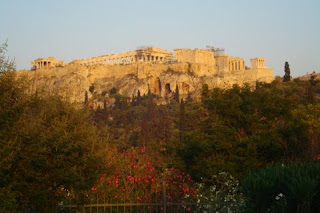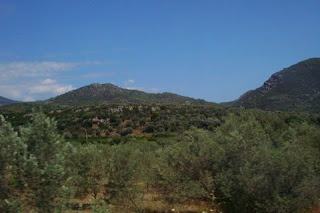Enjoying a relaxing moment in Thisseion
When I visit Greece, I don't go as a tourist. I've invested 32 years of my life in this country, much of it in Athens, so I consider myself sort of an honorary citizens. From my first trip there in 1979 to my most recent, whenever I go there I feel I am at home. Over the years a great many of my friends have passed on or gone back to their own homelands, but I still have friends who live in Athens and these people are part of my Athens family. We've known each other a long time!
View of the Acropolis from Thisseion
I never get tired of going to Athens and visiting all the old familiar places. When I go I also plan visits to places I have never been to -- believe it or not there are still a great many islands and parts of the country I have not yet seen. But I still love just hanging out in my old haunts and retracing former footsteps.
The little tourist train
Even though I know my way around, sometimes it's fun to hop the little tourist train and go chugging through the narrow laneways, a pretty neat way to get from one side of Plaka to the other without walking if it's hot. My friend and I took the train again this summer, from Plaka to Thisseion. You can hop on and off wherever you want so we always hop off in Thisseion where there are comfortable sidewalk cafes and great views of the Acropolis.Monastiraki
I always wander around to check out what's new in the shops in Plaka and Monastiraki. Sometimes I try out different places to eat but I still like going to some of the tavernas where my friends and I used to hang out. When I went by my favorite taverna next to the Roman agora last summer I found out that my friend Ari, the waiter, had retired and moved to Patras. The old Dirty Corner is now the Posh Corner and the Moroccon Chicken Corner is now a more spiffied up eatery on the corner of Kidatheneon and Adrianou. My favorite taverna in Plaka Square is closed now, and too bad as they had music and dancers. You could sit in the Square and take in the show for free. I still hang out all the time at the To Kati Allo on Hatzichristou St. I've known Anna and Leonidis, the people who run it, for years. Their son Dino, who helps his parents and waits on tables, is now a father with two kids and an American wife. I've known him since he was a little boy. Not many of the same patrons grace the tables there nowadays, and it is a nostalgic time for me as I miss my friends Robbie and Graham and some of the other gang. (Both of them passed away a few years ago). But I still meet my girlfriends there, and dear old Ove the Danish scholar is usually sitting inside so we have a chat.
The Agora
It doesn't matter how many times I have climbed the Acropolis Hill, I still feel in awe of it. The same goes for the Agora. I know every stone by heart but I love it there. I remember that on my first trip to Greece, the first day I arrived in Athens I let my feet take me walking not knowing where I'd end up, and I ended up in the Agora. That was a huge dejas vu moment for me, as when I looked around it seemed a curtain had been lifted and I 'saw' it as it had been. It was such an emotional experience, I stood there and cried. I never tire of wandering around that whole ancient area including the Hill of Nymphs and the Pnyx. I am familiar with the history and can imagine what it must have been like when ancient Athens was at the peak of her glory.The New Acropolis Museum
Same goes for the Museums. I love visiting the museums although I try not to overdo it. This year I made another trip to the Acropolis Museum which is fabulous. And another day I went to the Benaki Museum because it's been a couple of years since I visited it. Parliament Buildings in Syntagma Square
I was curious about the protesters in Syntagma Square. On the night I arrived I had to walk through the street by the Parliament that was cordoned off by heavily armed police and military. I worried that I was walking into one of those riots the media has been quick to report. But no, it was only the peaceful protesters. Some speeches were being made but otherwise it was more like a festive atmosphere. I went back several time to take photos of the tent camp. I never saw any violence while I was there and when it did happen it was only in the area around the Square. Everywhere else was peaceful.Peaceful Protestors
I love riding the trams, metro and buses and know my way around quite well. Sometimes my friend and I take the tram to the beach for a late afternoon swim. The metro system in Athens is excellent and some of the stations are like mini museums. (You have to watch out for pickpockets though.) When I lived there in the '80's I tutored English all around the city so I grew very familiar with the various areas of Athens.
Of course it's sad to see how the economic situation has affected the Greek people. There are many closed shops and unemployment and constant strikes, and the people are worried. But Greeks are resilient people and hopefully they will rally and eventually all will turn out okay.
I know I'll keep going back to Greece as long as I am able to travel. I am constantly torn between wanting to be there and having to be here. There have been a couple of times I meant to return there to live, but now it is more practical for me to be here. But it will always be my second home. And I can hardly wait to go back again!
Temple of Olympian Zeus with Lycebettus Hill in the background






























































